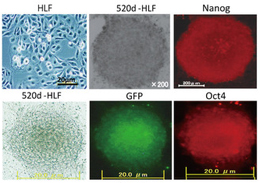Research Abstract
Hsa-miR-520dは、幹細胞性が介在するメカニズムにより、肝がん細胞を正常肝組織へと形成誘導する
Hsa-miR-520d induces hepatoma cells to form normal liver tissues via a stemness-mediated process
2014年1月24日 Scientific Reports 4 : 3852 doi: 10.1038/srep03852

ヒトncRNA遺伝子RGM249は、がん細胞の分化度や293FT細胞のhiPSCへの形質転換を制御する。我々は、この過程の根底にある主因子を同定するために、レンチウイルスを用いたmiR-520dの発現誘導の効果を、in vitroでヒト腎メサンギウム細胞(293FT)およびヒト未分化型肝がん細胞(HLF細胞)において検討した。次に、異種移植モデルにおいて腫瘍形成を評価した。導入後、形質転換したHLF細胞は、24時間以内にOct4およびNanogが陽性になり、p53の高発現およびhTERT の発現制御を示し、また遊走能をほぼ喪失させた。レンチウイルス感染後に、その細胞をマウス腹腔内に注入すると、1か月後、注入部位には良性奇形腫(6%)、腫瘍非形成(87%)あるいは正常肝組織への分化(7%)を誘導し得た。我々は、単一のマイクロRNA(miRNA)の発現を介し、in vivoでのがん細胞の悪性形質の喪失を初めて実証した。このmiRNAは、293FT細胞および肝がん細胞のhiPSC様細胞への変換を可能にした。 悪性度の高い腫瘍がmiR-520dにより制御された結果、p53の高発現を維持しつつ癌細胞を正常幹細胞系へ変換するという現象が現実に起り得るということだ。
津野 智史1, 王 心慧1, 庄盛 浩平2, 長谷川 純一1 & 三浦 典正1
- 鳥取大学医学部 病態解析医学講座 薬物治療学分野
- 鳥取大学医学部 基盤病態医学講座 器官病理学分野
The human ncRNA gene RGM249 regulates the extent of differentiation of cancer cells and the conversion of 293FT cells to hiPSCs. To identify the factors underlying this process, we investigated the effects of lentivirally inducing miR-520d expression in 293FT and HLF cells in vitro. Subsequently, we evaluated tumor formation in a xenograft model. Transformed HLF cells were Oct4 and Nanog positive within 24 h, showed p53 upregulation and hTERT downregulation, and mostly lost their migration abilities. After lentiviral infection, the cells were intraperitoneally injected into mice, resulting in benign teratomas (6%), the absence of tumors (87%) or differentiation into benign liver tissues (7%) at the injection site after 1 month. We are the first to demonstrate the loss of malignant properties in cancer cells in vivo through the expression of a single microRNA (miRNA). This miRNA successfully converted 293FT and hepatoma cells to hiPSC-like cells. The regulation of malignancy by miR-520d appears to be through the conversion of cancer cells to normal stem cells, maintaining p53 upregulation.

